5 Tips to Transport a Skidder
What is a skidder? A skidder is an innovative piece of equipment, able to pull heavy logs, typically used in the forestry industry. These machines will transport cut trees or cut timber along the ground. When the equipment pulls the load, it will skid across the terrain, and that’s how the skidder got its name.
Know Your Type of Skidder
There are two ways to classify this machine: cable skidder and grapple skidder. Each skidder will come with a cable or grapple drum, and each functions slightly differently.
Cable Skidders
The cable skidder will use cables that wrap around the logs. This log skidder will have a skid line with chokers attached, and the number of chokers used will depend on how heavy or what size the load is.
Grapple Skidders
A grapple skidder has a movable grapple claw at the back and can pick up and drag significant loads of logs. These machines typically work in tandem with feller bunchers because the feller buncher can cut, hold and place bundles of timber on the ground for the skidders to take.
These useful machines usually operate in forest areas far from the main roads. How can you safely transport these machines to these secluded destinations? Here are five tips on how to efficiently and safely transport skidders.
2. Identify the Equipment Needed
Whether your skidder has a grapple or cable attachment, these machines are typically quite wide and lengthy in size. Skidders can’t travel by just any ordinary trailer. It is essential to haul skidders with the correct equipment to ensure the safety of you, your crew and others on the road.
A skidder is categorized as an oversized load and needs to follow the guidelines for that type of equipment/machinery. If you decide to transport this equipment yourself, ensure you have the correct type of truck and trailer.
Due to its size, you will need a trailer that can hold up to 150,000 lbs. Removable gooseneck trailers are frequently chosen for this type of work because they can accommodate the weight and length of a skidder.
3. Ensure Thorough Preparation
Good preparation before any task or activity is crucial for success. When transporting heavy equipment that potentially can cause risk to others, ensuring you cover all possible outcomes beforehand can help with smooth travel.
To cover all your bases, go through the steps of transporting and prepare a risk assessment document. Doing this procedure can help you identify potential safety risks and can determine what safety measures to put in place.
An example of a safety procedure to put in place beforehand is proper PPE (Personal Protective Equipment) for all workers and staff during the transport journey. This assessment can also help you determine possible hazards while loading and unloading your equipment.
4. Establish Safe Loading & Unloading Habits
Before getting started, determining safety routines around loading and unloading can help ensure safe travel for the equipment, your team and others on the road. Before moving your skidder, laying out and designating duties to staff can help decrease risks.
Your team must know what they are doing and what tasks to complete. Hiring someone who is inexperienced can lead to potential damage to your equipment or injuries to the people involved.
Another way to ensure that loading and unloading procedures to go smoothly is by ensuring that your trailer is on flat, level ground. It is also crucial there is nothing surrounding your trailer that could potentially cause risks or get in the way. This could include build up of snow, other vehicles, or even people and animals.
Lastly, securing your skidder is another important factor when transporting oversized loads. All equipment and attachments need to be secured firmly to the trailer, and all doors/openings need to be closed.
Once on the road, your trailer must follow all road permits and conditions.
5. Cover All Essential Permits
Along with specialized trailers, these loads will require specific kinds of permits and escort cars. If you are transporting through the U.S.A or Canada, each state/province will have specific requirements for shipping oversized loads.
It’s essential that you check your province/state regulations and abide by these rules for safe travel. Some states/provinces will require pilot cars (vehicles that drive in front or/and behind the load to inform other drivers of an oversized load). Most states/provinces will need red tape or flags to identify your truck as a heavy load.
When considering cross-border transport between Canada and the United States, several documents will need to be signed beforehand. It can be beneficial to consider hiring a customs broker/border broker. Customs brokers are knowledgeable agents licensed by the Government and can help guide you through the paperwork needed for cross-border inspection and transport.
5. Hire the Experts
It’s still important to know the ins and outs of transporting heavy equipment like a skidder, but as you can see, a lot goes into oversized transportation. The experts at Trusted Dispatch can help make the process of transporting a skidder simpler. Our app will pair you with knowledgeable, skilled, vetted truckers who can help your transport journey run smoothly.
Skidder Transporters Alberta
If you’re looking for a trucking company to transport your skidder, look no further than Trusted Dispatch. Our trucking app will keep you up-to-date with your machine’s journey. It’s essential your equipment arrives safely at its desired destination, and at Trusted Dispatch, our goal is to help you achieve that. Contact us today or check our website to receive a free quote!



